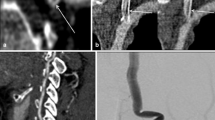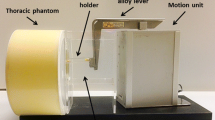Abstract
The accuracy of 16-row multidetector CT in the visualization of different peripheral artery stents and in the appraisal of in-stent stenosis was assessed. Nine different stent types (nitinol and stainless steel) with three diameters (6, 8 and 10 mm) were used; altogether 27 stents were analyzed in a barrel-shaped vascular model. Low-grade (<40%) and high-grade (>60%) in-stent stenoses were simulated by polyurethane sticks (70 HU) of differing diameters (2–6 mm). Imaging was performed with 16×0.75-mm detector collimation, 130 mAs, 120 kV, 12-mm table feed/rotation, 1.0-mm slice thickness and 0.5-mm increment. The stent diameter, strut thickness, in-stent attenuation values, degree and degree of in-stent stenosis were evaluated. Nitinol stents showed significantly (P<10−6) less stent lumen narrowing, artificial strut thickening and overestimation of the degree of in-stent stenoses than stainless steel stents. In-stent attenuation values and artificial strut thickening were significantly (P<10−6) lower in 10- and 8-mm stents than in 6-mm stents. Stent lumen narrowing was significantly less in 10-mm stents than in 8-mm (P<10−4) or 6-mm (P<10−6) stents. In-stent stenoses were significantly overestimated, irrespective of the stent diameter. In 6-mm stents overestimation was significantly higher than in 8-mm (P<0.01) or 10-mm stents (P<10−6). Under in-vitro conditions 16-row MDCT allowed an accurate identification of in-stent stenosis, but significantly overestimated the effective degree of the stenosis.




Similar content being viewed by others
References
Lawler L, Fishman E (2003) Multidetector row computed tomography of the aorta and peripheral arteries. Cardiol Clin 21:607–629
Ofer A, Nitecki S, Linn S, Epelman M, Fischer D, Karram T et al (2003) Multidetector CT angiography of peripheral vascular disease: a prospective comparison with intraarterial digital subtraction angiography. Am J Roentgenol 180:719–724
Ota H, Takase K, Igarashi K, Chiba Y, Haga K, Saito H et al (2004) MDCT compared with digital subtraction angiography for assessment of lower extremity arterial occlusive disease: importance of reviewing cross-sectional images. Am J Roentgenol 182:201–209
Strotzer M, Lenhart M, Butz B, Volk M, Manke C, Feuerbach S (2001) Appearance of vascular stents in computed tomographic angiography: in vitro examination of 14 different stent types. Invest Radiol 36:652–658
Maintz D, Fischbach R, Juergens K, Allkemper T, Wessling J, Heindel W (2001) Multislice CT angiography of the iliac arteries in the presence of various stents: in vitro evaluation of artifacts and lumen visibility. Invest Radiol 36:699–704
Maintz D, Tombach B, Juergens K, Weigel S, Heindel W, Fischbach R (2002) Revealing in-stent stenoses of the iliac arteries: comparison of multidetector CT with MR angiography and digital radiographic angiography in a Phantom model. Am J Roentgenol 179:1319–1322
Kramer S, Gorich J, Aschoff A, Orend K, Mickley V, Sokiranski R et al (1998) Diagnostic value of spiral-CT angiography in comparison with digital subtraction angiography before and after peripheral vascular intervention. Angiology 49:599–606
Mahnken A, Buecker A, Wildberger J, Ruebben A, Stanzel S, Vogt F et al (2004) Coronary artery stents in multislice computed tomography: in vitro artifact evaluation. Invest Radiol 39:27–33
Hahnel S, Trossbach M, Braun C, Heiland S, Knauth M, Sartor K et al (2003) Small-vessel stents for intracranial angioplasty: in vitro comparison of different stent designs and sizes by using CT angiography. Am J Neuroradiol 24:1512–1516
Maintz D, Juergens K, Wichter T, Grude M, Heindel W, Fischbach R (2003) Imaging of coronary artery stents using multislice computed tomography: in vitro evaluation. Eur Radiol 13:830–835
Flohr T, Ohnesorge B, Schaller S (2004) Current achievements and future developments in multidetector-row computed tomography. Radiologe 44:113–120
Trossbach M, Hartmann M, Braun C, Sartor K, Hahnel S (2004) Small vessel stents for intracranial angioplasty: in vitro evaluation of in-stent stenoses using CT angiography. Neuroradiology 46:459–463
Author information
Authors and Affiliations
Corresponding author
Rights and permissions
About this article
Cite this article
Herzog, C., Grebe, C., Mahnken, A. et al. Peripheral artery stent visualization and in-stent stenosis analysis in 16-row computed tomography: an in-vitro evaluation. Eur Radiol 15, 2276–2283 (2005). https://doi.org/10.1007/s00330-005-2797-7
Received:
Revised:
Accepted:
Published:
Issue Date:
DOI: https://doi.org/10.1007/s00330-005-2797-7




